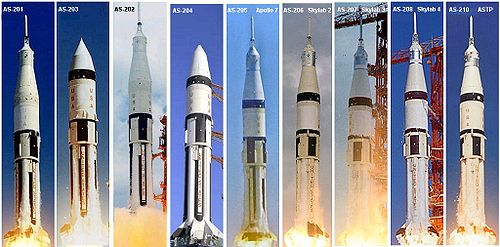Saturn IB
This increased the Saturn I's low Earth orbit payload capability from 20,000 pounds (9,100 kg) to 46,000 pounds (21,000 kg), enough for early flight tests of a half-fueled Apollo command and service module (CSM) or a fully fueled Apollo Lunar Module (LM), before the larger Saturn V needed for lunar flight was ready.
The only major difference was that the S-IVB on the Saturn V burned only part of its propellant to achieve Earth orbit, so it could be restarted for trans-lunar injection.
This mission supported the design of the restartable version of the S-IVB used in the Saturn V, by observing the behavior of the liquid hydrogen in weightlessness.
When the Apollo program was started in 1961 with the goal of landing men on the Moon, NASA chose the Saturn I for Earth orbital test missions.
It would also allow launching the 32,000-pound (15,000 kg) lunar excursion module separately for uncrewed and crewed Earth orbital testing, before the Saturn V was ready to be flown.
Data from:[7] General characteristics Engine The S-IVB was built by the Douglas Aircraft Company at Huntington Beach, California.
The S-IVB-200 model was similar to the S-IVB-500 third stage used on the Saturn V, with the exception of the interstage adapter, smaller auxiliary propulsion control modules, and lack of on-orbit engine restart capability.
Located at the top of the S-IVB stage, it consisted of a Launch Vehicle Digital Computer (LVDC), an inertial platform, accelerometers, a tracking, telemetry and command system and associated environmental controls.
In the Saturn IB and V, the range safety system was permanently disabled by ground command after safely reaching orbit.
This was done to ensure that the S-IVB stage would not inadvertently rupture and create a cloud of debris in orbit that could endanger the crew of the Apollo CSM.
1 was modified, adding an elevated platform known as the "milkstool" to accommodate the height differential between the Saturn IB and the much larger Saturn V.[9] This enabled alignment of the Launch Umbilical Tower's access arms to accommodate crew access, fueling, and ground electrical connections for the Apollo spacecraft and S-IVB upper stage.






